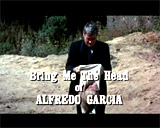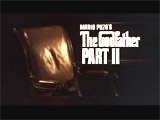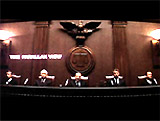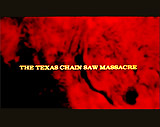
|
![]()
Greatest Films of the 1970s
1970 | 1971 | 1972 | 1973 | 1974 | 1975 | 1976 | 1977 | 1978 | 1979
Title Screen Film Genre(s), Title, Year, (Country), Length, Director, Description 

Alice Doesn't Live Here Anymore (1974), 112 minutes, D: Martin Scorsese



Blazing Saddles (1974), 93 minutes, D: Mel Brooks
The iconoclastic, non-politically-correct western was one of director Mel Brooks' funniest, most successful and most popular films, with non-stop jokes and slapstick. It was an unsubtle spoof or parody of all the cliches from the time-honored genre of westerns. Brooks' third feature film tagline blurb advertised: "Blazing Saddles...or never give a saga an even break!" The crude, racist and sexist film with toilet humor (the infamous bean-eating campfire scene) and foul language included the main elements of any western - a dance-hall girl, a gunslinger, a sheriff, a town full of pure folk, and more, but it twisted them around. In the film's opening, Frankie Lane sang the theme song (with the sound of cracking whips) about "Blazing Saddles" - referring to a cowboy who "made his blazing saddle a torch to light the West." In the small frontier town of Rock Ridge (an all-white racist place with all the townspeople named Johnson) in the 1870s, the homogenous townsfolk who were meeting in the town's church were faced with a decision to either leave or stay in the lawless town. They decided to petition the Governor to send the town a new sheriff - because every Sheriff appointed by the townspeople has been murdered. Dim-witted, near-sighted, corrupt and sex-obsessed Governor William J. Le Petomane (Mel Brooks) first appeared (in his underwear) nuzzling into bosomy secretary Miss Stein's (Robyn Hilton) cleavage. He was in cahoots with his evil and corrupt State Attorney General Hedley Lamarr (Harvey Korman). The Governor was scheming for a cheap land grab of the town where a railroad route was about to be constructed. The Attorney General turned the idea of a law-and-order sheriff into his own advantage, to panic the citizens so that they would cheaply sell out their land to him. Their plot was to take over the town of Rock Ridge (in the path of the railroad) by scaring off the townsfolk and replacing them with their own thugs, led by villainous Taggart (Slim Pickens). Pardoned black railroad worker Bart (Cleavon Little) was appointed as the new Sheriff. The assumption was that the bigoted townsfolk would immediately leave town once they saw the black Sheriff - thereby leaving the town vulnerable to take-over. Naive Bart (in a gaudy but fashionable cowboy outfit) rode into Rock Ridge to be greeted by a welcoming ceremony - during his acceptance speech, he warned the townsfolk as he reached down into the front of his pants: "Excuse me while I whip this out" - to the sound of their gaspings. When the townspeople soon realized that he was a "ni-," they threatened to shoot him. To divert the mob, hold them at bay and escape, Bart held a gun to his own neck, shouting: "Hold it. The next man makes a move, the n----r gets it...Drop it!" The drunken former gunslinger The Waco Kid (Gene Wilder), in jail in town, soon allied with the new Sheriff, to save the town. German seductress-for-hire Lili von Shtupp (Madeline Kahn), a spoof of Marlene Dietrich in Destry Rides Again (1939), Rock Ridge's saloon singer, was asked by Lamarr to seduce sheriff Black Bart, a scene that parodied Jean Harlow in Hell's Angels (1930). After the lights were turned out, she asked Bart if black men were "gifted," and went to investigate his physical endowments in the dark - she was memorably impressed - and Lili was the one who was seduced. When the Waco Kid, Bart, and the townspeople of Rock Ridge learned of Lamarr's evil plan to recruit vicious criminals to assault their town, they enlisted the aid of black railroad workers to build an exact replica of Rock Ridge, and to lure Taggart and his gang of men to destroy it instead of the real town. The absurdist destructive brawl between the good guys and the bad guys abruptly ended - when the camera pulled back to show that the film was being shot on a present-day Hollywood set in the middle of Los Angeles. The action broke through onto an adjoining film set where effeminate Buddy Bizarre (Dom DeLuise) was directing a musical. The chaotic fighting from the Blazing Saddles brought two conflicting film genres together, and degenerated into a major fight in the studio's commissary where bikini clad actresses, a Hitler-look-alike (Ralph Manza), and others were eating. The Adolph Hitler character responded to a question about how many days he had left: "They lose me right after the bunker scene," as the place erupted into a 'great pie fight.' The melee spilled out onto the streets of Burbank and the landmark Grauman Chinese Theatre in Hollywood. Bart pursued Hedley who ran from the movie theatre and shot him in the groin. Then he joined his buddy the Waco Kid to watch the ending of movie that was playing inside -- Blazing Saddles. The film ended with a happy conclusion - in the screened film - as the people of the saved town of Rock Ridge said goodbye to their black sheriff. Bart bid them goodbye with an obligatory farewell speech about how he was moving on. He invited the Waco Kid to join him, and they rode out of town into the desert where they dismounted, entered an awaiting limo, and drove off 'into the sunset.'




Bring Me the Head of Alfredo Garcia (1974, US/Mex.), 112 minutes, D: Sam Peckinpah




Chinatown (1974), 131 minutes, D: Roman Polanski
Director Roman Polanski's atmospheric, subtly-paced, superbly-made neo-noir mystery told about a hard-nosed detective uncovering urban corruption in late 1930's Los Angeles. World-weary gumshoe Jake Gittes (Jack Nicholson), who specialized in adultery cases, took on Evelyn Mulwray (Faye Dunaway) as a client. He was hired by the recently-widowed woman to investigate the infidelities of her alleged husband, the water commissioner for the drought-stricken city. As the film-noir plot unfolded, the detective was way over his head in a case involving murder, the illegal diversion of water to artificially deflate land prices, fraudulent and corrupt politicians including sinister millionaire Noah Cross (John Huston) grabbing up land, and a prominent family's scandalous, long-hidden dark secret. He uncovered many layers, facades and networks of corruption, conspiracy and deception. Nicholson's multi-faceted performance struck a responsive chord after the scandalous Watergate era of the early 1970s. He was masterful as he flippantly and self-confidently offered pat explanations for the deeply-flowing corruption he unearthed, and then found that he had to continually revise his inaccurate pronouncements and backtrack, after uncovering further evidence. His transgressive snooping was symbolized throughout the film by a large bandage on his sliced nose, after it was slashed by a punk (director Roman Polanski in a cameo role). After original, complex plot twists, the film ended in an unsettling finale in the 'Chinatown' section of the city - a state of mind where the law was ineffectual. Gittes found himself impotent and powerless to prevent the inevitable tragedy that he had exposed.


The Conversation (1974), 113 minutes, D: Francis Ford Coppola
Director Coppola's brilliant thriller and murder mystery, one of the best films of the 1970s, was made during the Watergate Era, and came at the height of Coppola's fame for his two Godfather films. Professional, reclusive, alienated, and paranoid surveillance expert Harry Caul (Gene Hackman), assisted by Stan (John Cazale), was hired by the 'director' (Robert Duvall in a cameo) of an anonymous business, in a seemingly-routine job, to secretly wiretap the conversations of two employees - an unfaithful wife and her lover (Cindy Williams and Frederic Forrest). After repeatedly playing back the tape, Caul realized that he had captured a terrifying conversation with clues about an impending tragedy - a death sentence. He felt compelled to intercede and circumvent fate with disastrous consequences.

The Godfather (Part II) (1974), 200 minutes, D: Francis Ford Coppola
Director Francis Ford Coppola's continuing saga of a Mafia family and dynasty was one of the few sequels in film history that has been considered superior to the original. This outstanding, Best Picture-winning film was a continuation of the first film and retraced the Corleone Family's founding by the young Vito Corleone (Robert De Niro), who immigrated to America from his native Sicily at the turn of the century and maneuvered his family to power in the ghetto of Little Italy. It also showed the maintenance of the family by young Michael (Al Pacino), Vito's son, as he aged and confronted a second generation of criminal and family affairs in Vegas, Cuba, and in a Senate hearing on organized crime. After eliminating all rivals and enemies, he was a brooding character, alienated from his wife (Diane Keaton), and the murderer of own brother Fredo (John Cazale).

Harry and Tonto (1974), 115 minutes, D: Paul Mazursky
Director Paul Mazursky's road film starred Best Actor-winning Art Carney as elderly widower and retired teacher Harry, a New Yorker facing the loss of his apartment building. He struck out from his Upper West Side home to travel cross country to find a new home, with his beloved feline pet Tonto.

Lenny (1974), 111 minutes, D: Bob Fosse


The Parallax View (1974), 102 minutes, D: Alan J. Pakula


The Texas Chainsaw Massacre (1974), 83 minutes, D: Tobe Hooper


That's Entertainment! (1974), 120 minutes, D: Jack Haley, Jr.


The Towering Inferno (1974), 165 minutes, D: Irwin Allen, John Guillermin

Vincent, François, Paul...and the Others (1974, Fr./It.) (aka Vincent, François, Paul... et les autres), 118 minutes, D: Claude Sautet

A Woman Under the Influence (1974), 155 minutes, D: John Cassavetes



Young Frankenstein (1974), 106 minutes, D: Mel Brooks
This was one of writer/producer/director Mel Brooks' best films - a nostalgic, hilarious spoof-tribute to classic horror films (with its authentic black and white cinematography and production design/set decoration), and in particular, of Mary Shelley's classic novel. This was his follow-up film to his westerns-spoof (Blazing Saddles (1974)) and one of Mel Brooks' many spoofs or parodies of various genres and sub-genres. The main character, young brain surgeon and med-school professor, Dr. Frederick Frankenstein (Gene Wilder) was in denial about his heritage, and had to continually and defiantly correct people about the pronunciation of his name: "That's Fronk-en-steen." The reluctant scientist returned to Transylvania when he inherited his infamous grandfather Victor's castle. At the town's train station, he was greeted by bug-eyed Igor ("That's Eye-gor") (Marty Feldman) with a shifting hunchback, and a pretty, dim-witted, voluptuous assistant from the village named Inga (Teri Garr). At the castle, he was introduced to old housekeeper Frau Bleucher (Cloris Leachman) who caused horses to whinny. He was inspired to finish his ancestor's mad work to create life after he found the journal book/diary "How I Did It" in his private library. His sexually-repressed, spoiled fiancee Elizabeth (Madeline Kahn) later joined him as he repeated his grandfather's famous experiments and recreated the Monster (Peter Boyle). The film ranged from slapstick and farce to dirty, bawdy humor to irreverent satire (e.g., a parody of the little girl drowning scene that was taken from Frankenstein (1931), and the blind hermit scene from The Bride of Frankenstein (1935) with Gene Hackman in a cameo role.) Some of the more memorable images were Elizabeth's encounter with the Monster and his "enormous schwanstucker" (singing "O Sweet Mystery of Life"), and the soft-shoe dancing and singing duet of "Puttin' on the Ritz" by the Monster and creator Frederick, complete with tuxedos, canes, and top hats.